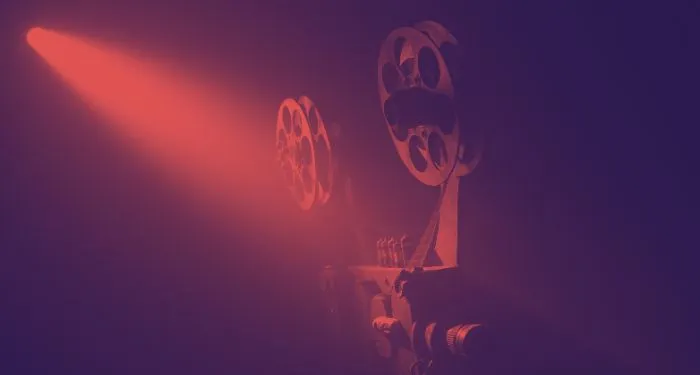A hijacked New York City subway train packed with petrified passengers is hurtling toward the South Ferry station. Walter Matthau, playing Lieutenant Garber of the New York City Transit Police, is negotiating with the hijackers over a two-way radio as funk bass patterns crisscrossing with the churn of atonal brass ratchet up the tension. David Shire’s score for The Taking of Pelham One Two Three, one of the truly great New York films of the 1970s, proves as integral to sustaining an atmosphere of fretful claustrophobia as Joseph Sargent’s keen-eyed direction.
The thought of subway riders hijacked not only by hoodlums but also by atonal music will no doubt leave Arnold Schoenberg’s detractors grinning. Atonal music, which Schoenberg pioneered, does away with the orientation of keys and the grounding of tonal centers, which has the effect of unraveling the reassuring resolutions and sweet harmonies associated with tonality. Films portraying psychological terror have long depended on atonal sounds to underpin suffocation and fear and to emphasize the sense that things aren’t quite right. The British composers Elisabeth Lutyens and Humphrey Searle, both committed post-Schoenbergians, scored horror films to supplement the meager income they earned from writing concert music in the 1950s and 1960s. Stanley Kubrick, with his unerring ear for finding exactly the music required for any scene, regularly drew on works by György Ligeti and Krzysztof Penderecki for his films—sound worlds traceable back to Schoenberg.
I raise these examples because Harvey Sachs’s Schoenberg: Why He Matters does not tell us what its title promises. The process of writing his book allowed Sachs, who defines himself as “Schoenberg-curious rather than a Schoenberg expert,” to explore the boundaries of his own relationship with this music. He skillfully sidesteps making heavy analytical weather of Schoenberg’s works. The composer’s life, from his birth in Vienna in 1874 to his death in Los Angeles in 1951, is compressed into two hundred pages. By page 32 Schoenberg is deep into the composition of his post-Wagnerian oratorio-slammed-into-a-melodrama Gurrelieder (1901–1911). Thirty pages later he is already thinking about atonality. By page 160 he has fled Nazi Germany and moved to the United States. The narrative, which doesn’t drop a beat until an epilogue, entitled “What Now?,” dodges any meaningful discussion of Schoenberg’s current status.
This strikes me as a wasted opportunity, both because Sachs is a first-rate musical thinker—his biography of the conductor Arturo Toscanini, Toscanini: Musician of Conscience (2017), is a dazzling piece of writing—and also because the significant questions left to answer about Schoenberg are wrapped up in his relevance, or perhaps lack of it, in times very different from his own. How Schoenberg carved a musical language to call his own out of Bach, Brahms, Mahler, and Wagner, then embraced atonality, then serialism—the systemization of atonality, composing by manipulating sequences of all twelve notes of the chromatic scale arranged into “tone rows”—in the final and most controversial phase of his career has been discussed exhaustively in biographies and studies, the best of them by Charles Rosen, Malcolm MacDonald, Allen Shawn, and Sabine Feisst. But debates over Schoenberg’s impact today too often default to predictably entrenched positions; 150 years after his birth there’s still scope for an informed and revisionist reevaluation.
The portrait Sachs sketches of this source of so much musical controversy is of an irascible, entitled individual supremely confident of both the innate superiority of German music and his assumed position as heir apparent to a lineage of compositional high achievement that stretched back to Bach. All this immediately places him at odds with where classical music is today: questioning the dominance of the Austro-German canon, more motivated to investigate composers considered neglected by history—Florence Price, Samuel Coleridge-Taylor, Ethel Smyth—than focused on any particular debate about where musical language heads next.
Softer sides of Schoenberg do emerge from behind the bluster. When his tennis partner George Gershwin died suddenly of a brain tumor in 1937, the bereft Schoenberg spoke on the radio about how his death represented a tragedy for American music, which implied he understood that not everyone should be following in the Austro-German tradition. We also learn that Schoenberg and Giacomo Puccini enjoyed something of a mutual fan club: Puccini traveled to Florence in 1924 to hear Schoenberg conduct a performance of his melodrama Pierrot lunaire (1912), while Schoenberg acknowledged Puccini’s innovative harmonic thinking.
No one could feel anything but sympathy for Schoenberg’s situation in October 1923, when his first wife, Mathilde, died of liver cancer at forty-six. Their marriage had been troubled from the start. Mathilde, the sister of the composer Alexander von Zemlinsky, had an affair with the painter Richard Gerstel, who stabbed and then hanged himself in his studio after their relationship ended. Amid this tragedy Arnold and Mathilde managed to patch together a workable marriage, although he would remain wary of his wife’s wandering eye. Her death, traumatic in itself, prized open those earlier traumas. Schoenberg’s attempts at multigenerational living with his grieving daughter Trudi, her husband, and their six-month-old son ended, entirely predictably, with door-slamming quarrels as the most minor of disagreements escalated out of all proportion. He moved out, confessing that “you cannot live with me…the whole situation is impossible.”
Schoenberg: hard to love, impossible to live with. Sachs excels at accounting for that queasy mix of self-assurance and the need to be the guy in the room who was always right. Growing up in Vienna in the Jewish neighborhood of Leopoldstadt—nicknamed, not respectfully, Matzah Island—the sixteen-year-old Schoenberg took a job as a bank clerk in 1889 to help support his family following his father’s death. But music, and the desire to compose, was already foremost in his thoughts. As an eight-year-old he had started violin lessons, and composing was his instinctive response to being stimulated by sound. A teenage friend and gifted violinist, Oskar Adler, gave Schoenberg some formative lessons in music theory; another friend, David Josef Bach, provided introductions to literature and philosophy, which eventually led Schoenberg to seek out Zemlinsky, who opened his ears to Wagner, Bruckner, and Liszt.
His preferred composer to that point had been Brahms, but Zemlinsky impressed upon him the importance of both Brahms (the master of “absolute” music) and Wagner (the creator of fresh thinking about opera) at a time when composers were prone to taking sides. Brahms and Bruckner, as well as Johann Strauss II, lived in the Vienna Schoenberg knew, as did Mahler, Gustav Klimt, and Sigmund Freud. Schoenberg later credited David Josef Bach with embedding within him the “ethical and moral power needed to withstand vulgarity and commonplace popularity.” Art, music, and literature clearly represented a higher calling than the brass band music and souped-up operatic extracts he had heard at public weekend concerts in the park.
Schoenberg’s Jewishness also led him to question the society in which he found himself, which Sachs describes as “predominantly Catholic and conservative.” His friends Bach and Adler were Jewish too, as were Mahler and Zemlinsky, and Schoenberg puzzled over why his understanding of society and culture felt so out of step with frothy Viennese decadence. Sachs extrapolates from this the useful idea that for the rest of his creative life
Schoenberg would see himself as a lonely David using his slingshot to fend off hordes of cultural Philistines who were incapable of grasping, or unwilling to grasp, the beauty and the importance of his ideas and his work.
He also makes the highly pertinent point that to his last breath Schoenberg remained tetchy about his lack of a rigorous conservatoire training and needed continually to prove his superiority.
His musical training might have been patched together—“haphazard,” Sachs calls it—but he began writing carefully considered music almost immediately. Sachs’s alluring descriptions of his earliest works, sets of lieder, sent me back to scores I hadn’t engaged with for too long. This music was perched between Brahms and Wagner, with echoes of Hugo Wolf, but I’d forgotten how explicitly Schoenberg’s itch to move beyond those models can be heard in his inquisitive harmonies and dense, searching writing for both voice and piano. Some of the songs were booed at their premiere, and he reflected subsequently that from that point on “the scandal has never ceased.”
The miracle of Schoenberg, really, is that his first widely acknowledged masterwork, Verklärte Nacht (Transfigured Night, 1899) for string sextet (and arranged later for string orchestra), emerged fully formed, and beautifully so, after only those early songs. Composed around the scenario of a poem by Richard Dehmel—during a walk in the woods at night a woman confesses to her lover that she has become pregnant by another man; her lover assures her that their love will “transfigure” the child, who will become theirs—the work sounds like the writing of a composer who had a stack of apprentice scores stowed safely away in a desk drawer. It reveals itself over a tautly controlled thirty-minute span, and Schoenberg finds immense freedom of gesture and harmonic uprush within his disciplined writing. His ear for the internal balance of string orchestration and his hunch for how the music would breathe over time in performance were remarkable for a composer who had written so little. Mahler was entirely convinced and helped Schoenberg financially. The work’s premiere, in 1902, upset a Viennese audience unprepared for its gamey harmonies, while others were offended by the sexual morality of Dehmel’s poem, and some no doubt by both.
If Schoenberg’s music can no longer shock like that, its power to challenge listening habits persists. In May 2023 I heard a performance of his String Quartet No. 1 in D Minor (1904–1905), played by the excellent Novus String Quartet at the Wigmore Hall in London. It was written after Verklärte Nacht and his first orchestral score, Pelleas und Melisande (1902–1903), and Schoenberg characteristically approached his first work in this notoriously difficult chamber medium as though he were already an established authority.
I knew it well from recordings, but confronting a major Schoenberg score for the first time in performance is a different matter. A forty-minute string quartet might be considered taxing enough, but Schoenberg denies any possibility of passive listening. Miss the inference of how even a single note lands inside his compactly composed, digressive music and you’re lost. Recurring rhetorical gestures or harmonic hooks, which help listeners orient themselves in works by Mozart or Beethoven, are swept away by the tangled impetuosity of Schoenberg’s musical argument. Active listening is required all the way. This is music at 150 percent concentration—and Schoenberg hasn’t reached atonality yet.
Listeners must engage critically, analytically even, with this First Quartet, music that exists only to express ideas about music; there is no program or extramusical concerns. To scorn that is to disparage the extreme care and hard work Schoenberg invested in creating the music. The suggestion instead that you use the experience of his First Quartet to deepen your understanding of musical discourse—to listen better—is a challenge you’re either prepared to accept or you aren’t. Certainly I left the Wigmore Hall that evening feeling ready to listen to anything.
The essence of Schoenberg’s art, tonal or atonal, was always found in that purist attitude toward composition he outlined in early pieces, like the First Quartet and his colossal Gurrelieder. Modern music culture would later become fixated on analyzing his tone rows, but it’s significant that he rarely spoke about his own music when teaching; student composers hoping he might offer crammer exercises in serial technique, guaranteed to lend their music a “modern sound,” were more likely to find themselves analyzing Bach or Mozart in granular detail. Schoenberg proclaimed himself against analyzing tone rows, which would lead “only to what I always fought against: the realization of how it was done, while I always aimed for the recognition of what it is!” Later he sought to put distance between his reputation as a theorist and the work he cared about more deeply, composition. “When I compose,” he wrote, “I try to forget all the theories and I continue composing only after having freed my mind of them.” Twelve-tone theory must never be thought of as “the music”; it was simply the technique through which he expressed himself.
There was a certain amount of having his cake and eating it too. The quote of his most likely to be repeated is that twelve-tone technique would assure “the dominance of German music for the next century.” Said, apparently during an evening walk with his pupil Josef Rufer, on the day in 1921 when the technique finally dropped into place, these words have often been used as a battering ram against him: surely the utterance of a megalomaniac, and with an unfortunate historical resonance, although one that he couldn’t have anticipated in 1921. But perhaps we can forgive Schoenberg a triumphalist moment after twenty-five years of dedicated attention to the craft of composing.
Aside from the occasional piece aimed at scratching a technical itch—the prime example being the notoriously arid Wind Quintet (1924), written while he was still testing twelve-tone theory—Schoenberg’s words about freeing his mind before composing ring true. He metamorphosed poetry by Albert Giraud into his thirty-minute Pierrot lunaire, sensitively elevating Giraud’s words while finding ways of making sound dance with death. The scenario required music that could convey the commedia dell’arte archetype of a man-made yet feeling puppet who becomes intoxicated by the moon and fantasizes about sexual conquests and religion. Giant moths blot out the sun. Pierrot indulges in grave robbing and blasphemy, then ends up on the gallows.
Schoenberg’s transformation of melodic motifs into overarching statements, pushing his Pierrot music forward impatiently, has often been discussed, but I’d like to put in a word for the suppleness of his ear: how he used harmony and instrumental sonority to conjure up this twilight world of compulsive lunacy. He assumed, correctly, that his listeners would be focused on the narrator, especially given that she would be declaiming in half-sung, half-spoken Sprechstimme, the technique of speaking along a melodic contour, which Schoenberg devised especially for Pierrot lunaire. Therefore his instrumental writing, for an ensemble of flute, clarinet, violin, cello, and piano, could not be orchestration as usual. The instrumental music wavers and fluctuates, as though quivering in sympathy with the cadaverous shiver of the narrator’s voice. Statements, confident at first, slide into instrumental registers—marginally too high or low—that smudge their attack. And having violin double viola, flute double piccolo, and clarinet double bass clarinet handed Schoenberg a “shadow ensemble” of shadier instrumental sounds with which he could spook his music. No, not the work of a theorist but of a hearing, feeling composer.
Sachs is very good at pinpointing comparable examples of Schoenberg’s well-honed ear operating over his analytical brain. The heft of the early Gurrelieder, Pelleas und Melisande, and Five Orchestral Pieces (1909) has led to the misapprehension that Schoenberg’s music leaned toward glutinous, unwieldy textures. However, Sachs issues a reminder that twelve-tone composition often thinned his textures. “The most immediately striking characteristic,” he writes of the Five Piano Pieces, op. 23, and Serenade, op. 24, for male voice and seven instruments (both 1920–1923), “is their delicacy.” The complex patterning of tone rows needed time and space to speak. Listeners had no chance of internalizing them otherwise. Schoenberg’s composerly instincts told him as much.
When Sachs thinks Schoenberg misfired, he says so. Peculiar difficulties with Schoenberg’s approach to text make his über-expressionist monodrama Erwartung a torrid experience for Sachs, but not for the reasons the composer intended. Sachs finds that the overdone hysteria of Schoenberg’s text, reworking words by Marie Pappenheim, undermines everything. Erwartung (1909) is essentially Verklärte Nacht flipped to its dark side. A betrayed woman searches for her man, finds his body, and is unsure whether she murdered him. The work, Schoenberg said, was that horrific split second of realization played out in slow motion over thirty minutes, but Sachs hears “shock-and-awe” tactics in both text and music beating listeners “into submission.” A subsequent stage work, Die glückliche Hand (1910-1913) influenced heavily by August Strindberg, he finds misogynistic. Schoenberg’s text is simply a mess, and the piece, again, suffers from “cataclysmic orchestral outbursts.”
By the time Sachs reaches his epilogue, you sense a writer ready to move on. No grand conclusions are reached; threads are left hanging. He references Joyce’s Finnegans Wake as another example of a Modernist artwork with limited appeal, while bemoaning the fact that he—“a musically trained person”—can follow a Schoenberg score, appreciate the brilliance of the writing, but is left wondering why this music is often “read” rather than listened to or enjoyed. For the public at large it has, he opines, “proven to be an evolutionary dead end.” But that is a vast oversimplification of a reality far more nuanced. The composers Schoenberg directly influenced—from Lutyens and Elliott Carter to Brian Ferneyhough—are indeed of interest to a specialist audience, but actually we listen to atonal sounds all the time, and serialism making horror films sound more bloodcurdling is just the beginning.
Twelve-tone music has also been used for comic effects. Scott Bradley, famous for scoring Tom and Jerry, Droopy Dog, and Barney Bear cartoons, wrote in a 1944 essay, “Music in Cartoons,” about how twelve-tone technique provided him with “the ‘out-of-this-world’ progressions so necessary to under-write the fantastic and incredible situations which present-day cartoons contain.” Synchronizing music frame by frame to the slapstick action on-screen required a system able to override the orderly cadences of musical syntax while injecting some anarchy, and Bradley found one by adapting twelve-tone technique to his own ends. Half a century later, musicians are still at it. The title track of the 2024 album by the New York jazz saxophonist James Brandon Lewis, Transfiguration, comes with a mention in Lewis’s liner notes about how he deployed twelve-tone technique as part of his interest in “renewal.” Harmonic markers never land where you think in the piece, and tone rows have clearly helped Lewis throw open compositional and improvisational possibilities unlikely to have been found through tonal patterning—twelve-tone thinking as a kind of compositional AI.
I understand Sachs’s reticence, as he notes in his prologue, to discuss atonal and twelve-tone music “used in film soundtracks or in other media in which the audience’s attention is mostly focused elsewhere” on the grounds that such situations are not primarily musical, but ignoring atonal film music when discussing Schoenberg’s legacy feels unconvincing. So much else about the aftermath of Schoenberg is missing too. A throwaway line, symptomatic of the problems, appears near the end of the book, after Schoenberg has immigrated to the United States, when Sachs sneaks in mention of the twenty-seven-year-old John Cage, who “continued to work under Schoenberg’s tutelage for several years, with many ups and downs in their teacher-pupil relationship,” but he leaves it at that.
Bypassing Schoenberg’s relationship with Cage, forgivable in a conventional biographical narrative, proves unwise in a book asking questions about why Schoenberg matters. Cage realized soon enough that writing twelve-tone music was not for him, but he divined a wider lesson from that model of arranging the twelve notes of the scale into a preordained order. The way Cage heard it, Schoenberg had imposed a neutralizing system from outside traditional musical grammar over the innate hierarchies of musical harmony, a realization that helped generate his own big idea: that sound could become detached from the internal order of harmony and that composers need not be defined by their own taste and the gestural habits of tonal music. Filtering out the harmonic impulse from music, then dealing with what was left—call it music, sound, or noise—would have profound implications for composition and emerging concepts of “sound art.”
Too often Schoenberg has been written up as the composer who swept the decks clean after Wagnerian and Mahlerian excesses inevitably toppled over and who enforced order upon Romantic harmonic wanderlust. But Schoenberg has consistently proved as much a beginning, a figure who inspired musicians to dig ever deeper into sound, as any sort of historical endpoint. Cage, who managed to isolate something specific out of Schoenberg’s method and then moved it in a direction his onetime teacher could never have dreamed—or indeed approved—of, exemplifies how the influence proliferated. The late-period work of Cage’s friend and composer colleague Morton Feldman demonstrated how objectifying systemization could be applied to material tonal in its inference, creating a music of delicate, poised beauty. His piano work For Bunita Marcus (1985) sounds like tonality with all the usual anchors and landmarks rubbed out.
The retort that Schoenberg mattered only to a narrow band of High Modernist fellow travelers—Carter, Pierre Boulez, Luigi Nono, Karlheinz Stockhausen, Milton Babbitt—whose music never captured the imagination or the affection of the music-loving public is never far away, but classical commentators, too often lacking the analytical tools to listen outside their own area, have repeatedly ducked the task of explaining why this is not the case. The atonal genie Schoenberg freed from the bottle turns up in the most unlikely places. Anton Webern—arguably Schoenberg’s most famous pupil—became a poster boy for avant-garde composition. But in mid-1960s Sheffield, England, the guitarist Derek Bailey got bitten by the atonal bug after stumbling across a Webern LP. Bailey, then a jazz guitarist obsessed with Charlie Christian and Wes Montgomery, heard Webern’s music dicing up sound in ways he hadn’t experienced before, which handed him new structures for improvisation. Jazz was out; free improvisation was in.
If Bailey, who became a guru of British free improvisation, feels too much of a musician’s musician around which to hang any claims about Schoenberg creeping beyond the confines of modern composition, how about Frank Zappa? Webern, Zappa said, “filled me with awe—I couldn’t believe anyone would write music like that,” and he revered Schoenberg equally. Sprechstimme helped Zappa to develop his approach to delivering a vocal. “A Nun Suit Painted on Some Old Boxes,” from his screwball film 200 Motels (1971), always sounds to me like an overt hat tip to his favorite Schoenberg work, Pierrot lunaire. Or how about Lou Reed, whose teenage interest in Lulu, the atonal opera by Schoenberg’s pupil Alban Berg, is another example of atonal music helping form a musical imagination? Lulu’s stark expressionism stuck with Reed, handing him the subject (and title) of a late album recorded with the metal group Metallica.
Brian Eno, whose boundless sonic imagination helped shape albums by David Bowie, Devo, and Laurie Anderson, as a young man found himself enthralled by postwar modernism and concepts derived from Cage. Schoenberg’s solidly compacted scores, in which every note must count, might feel antithetical to ambient composition, the music for which Eno is most famous. Ambient pieces, usually electronic, exist not to be performed but as a means of using sound to accentuate the dimensions of a space. Eno’s harmonies, caressing the corners of a room, flowing around the architecture, have no need for representational musical narrative. His no-gravity music liberates notes from their usual tonal function through objectivizing algorithms, an idea that has always felt to me like a distant cousin of Schoenbergian tone rows zapping harmonic hierarchies.
Who knows whether Eno, producing U2 albums, has discussed Schoenberg with Bono, but the atonal genie helped shape his sensitivity to listening and remains inside everything he does. Schoenberg dwells in places you wouldn’t even think to listen. Horror films, cartoon cats chasing cartoon mice, jazz, Cageian concepts of chance, free improvisation, rock, pop, and ambient music—not a note of it would have mattered to him. But let nobody say he doesn’t matter.



















 English (US) ·
English (US) ·